Archive for ‘Mail & Shipping’ Category
Moving? Here’s Your No-Stress Change of Address Checklist

ADVENTURES IN MOVING
A month ago, my best friend of almost forty years called me from her car. “Where are you?” I asked, expecting her to be somewhere en route between where she lives in New Jersey and somewhere near New York City. I was surprised to find out that she was in Central New York, headed toward Western New York (where I’m from), to look for a house to buy!
My BFF and her significant other had gone to a financial advisor to talk about the usual financial and tax planning topics as they approach a decade that will see many changes — from the last of the “kids” leaving home to their eventual retirements. Among his suggestions was to buy a home. While that wasn’t feasible in the very expensive area where they currently live, they contemplated moving closer to the areas where both had grown up.
Apparently, the housing market is pretty wacky right now. Home prices are up 30% from where they were just before the pandemic, a mere five years ago! Inventory is low, and demand is high. The morning I spoke to my friend, she’d had a list of six houses to look at the next day; by the time we chatted, three had already sold. Forty-eight hours later, they’d bought a (cute) house!

Photo by David Gonzales on Pexels (And no, that’s not my BFF’s house, but it’s cute.)
One of my other closest friends recently surprised me with a home announcement, too. He and his new spouse live in the south in separate cities; they’ve been working toward finding a city that worked for both of them as one can work remotely and the other was contemplating retirement.
This summer, while visiting a friend in the northeast, they decided to explore communities within driving distance, and unexpectedly found their “forever” home and, like my BFF, closed on a house quickly. Their move is happening as I write this!
As my area of expertise is paper, my initial concerns for both friends involved making sure they were registered to vote in time (per my advice in The Ultimate Guide to Organizing Yourself to Vote) and that they’d get their addresses changed so they’d be sure to get their mail and not miss any important notices or payments.
WHY YOU MIGHT CHANGE YOUR ADDRESS
Is mail that important? I mean, most of us get a lot less paper mail than we used to. Fewer people send cards and letters; people post their vacation photos on social media instead of sending postcards. Many folks take advantage of a one-time $5 credit if they get their utility bills by email (or have them auto-debited with email or text notifications after the fact).
Still, mail is can be vital, and making sure that your mail gets to you will make at least one aspect of the moving process less stressful. There are a few different kinds of address changes:
- Permanent changes of address for all concerned — This happens when you (and possibly your family or household members) change houses (or apartments) and leave (theoretically) for a different home.
- Permanent changes of address of address for only one member of a household, such as when one person moves out after a divorce, ostensibly never to return.
- Temporary, but long-term change of address for one person — Let’s say your kid is headed to college. If she’s staying in town and coming home every week to do her laundry and “borrow” the contents of your fridge, maybe no change of address is necessary. But if she’s headed across the state or country, she’ll want to change her address for most things until May, when she either moves back or tells you she’s going to bum around Europe to find herself.
- Temporary change of address for one person — There are various reasons for this option, but all involve being away from your home (for work or other obligations) for a length of time, with an expectation of returning.
Last November, Paper Mommy fell and broke her pelvis, then contracted pneumonia, and due to some medical neglect that makes me want to punch walls, had three hospitalizations and two stints in rehab over the course of two months.
My mother didn’t need to change her address to the hospital or rehab location — a family friend was able to collect her mail and bring it to her. But my sister, who relocated from her home state to my mom’s house for most of two months (and worked remotely while helping with my mom’s recovery), did redirect her mail, temporarily.
Similarly, I’ve had clients who have home bases but travel extensively and long-term for work. One relocates for six weeks out of every quarter to train different divisions of her company.
Another client is a “locum tenens,” a Latin word that refers to medical professionals (or sometimes clergy) who work temporarily in different locations. For example, travel nurses are temporary healthcare professionals who are hired to address staffing shortages, particularly when patient volume surges or there are higher seasonal demands. Assignments can range from four weeks to much longer, and 13-week assignments are not unusual. Nobody wants to be without their mail that long.
Some locums return to a home base between jobs; others move from one job to the next, living in temporary housing in each location. Getting mail wherever they are feels a bit more like home.
HOW TO CHANGE YOUR ADDRESS
Whatever your reason for changing your address, you’re going to want to organize your approach.
Get the details right
Do not pass go, do not collect $200. Before you submit your change off address for official notifications or share your new digs with friends, make sure you have the details exactly correct, including the full ZIP Code with extension.
I live in an apartment, and my address includes a street address (that applies to thousands of residents of many hundreds of apartments) as well as an apartment number, which is mine alone. Over the years I’ve been here, several new residents have mistakenly listed my apartment number as theirs, and I’ve gotten their mail and packages.

If the mail looks important, I’ve tried to find the person via social media and meet them in the parking lot to give them their mail; if it doesn’t seem vital, I usually write “no such addressee at this location” and return it to to the post office. But not everyone will do that, and you really don’t want to risk your mail or packages ending up with someone who isn’t as cool as Paper Doll.
- Verify your exact address with your real estate agent, landlord, or apartment complex management. You may need to start the change of address process before you get all your paperwork, so be sure to clarify via text or email to ensure it’s correct.
- Don’t make assumptions regarding the address based on what you’ve seen when visitinh. On Friends, Monica Gellar’s apartment’s fictional address 495 Grove Street; the building you see on the show is actually 90 Bedford Street, at the corner of Bedford and Grove in Manhattan. You’re not a TV character, but your home may have an address on one street even if the main (or only) entrance is on the cross street.
- Double-check to make sure that your new home is properly identified as Road, Court, Lane, Boulevard, Circle, etc. Many subdivisions have similar street names with only the final qualifier differentiating among them. (Want to go down a rabbit hole? Read What’s the Difference between an Ave, St, Ln, Dr, Way, Pa, Blvd, Etc.?)
A few months ago, I was on the phone with a friend who built a home in a new subdivision. He’d been delivered a package for a home with the same number as his on the next street over. He thought he’d do a good deed and walk the package over to them while we chatted. Unfortunately, the next street over was not numbered the same way, so the true recipient’s home wasn’t approximately behind his, but much farther away. Eventually, he cut through some backyards back to his house, got his car, and re-attempted the delivery. Again, not everyone is that helpful!
- Double-check the directional terms, like 129 West 81st Street (that’s Jerry Seinfeld’s place, in Apartment 5A). Make sure you ask for sound-alike numbers (five/nine, fifth/sixth) to be spelled out (in case you get Mr. Rogers’ old 4802 Fifth Avenue house).
- If you’re buying a recently-constructed home, triple-check. Sometimes, a developer may change the street names between when the plans were submitted to the post office and the municipality put up the street signs.
- Check to see if your street is actually registered with the post office. It’s hard to believe, but some developers sometimes forget this step.
![]()
This is fairly easy. Look up your address on the United States Postal Service ZIP Code Lookup site. Enter what you have of the address, and it should return the proper ZIP Code, including the four-digit extension.
You can enter the address to get other details, the city and state to figure out the ZIP code, or the ZIP code to determine the right name for your location. For example, my childhood home is considered in Buffalo, New York, but known by other names:
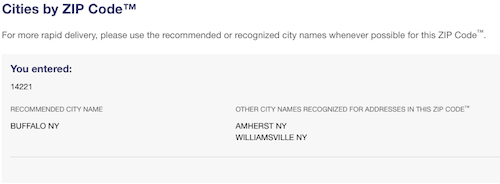
WHO NEEDS TO KNOW TO KNOW YOUR NEW ADDRESS?
Once you know to where you’re relocating, start spreading the news.
Start with the Post Office
Submit a change of address through the United States Postal Service. You can walk in to any post office and fill out a change of address form, or file a change of address online. (The USPS page also helps you change your address for the purposes of changing your voter registration address.)
Click to identify whether this is a change of address for an individual, family, or business. Provide your full name and email address (to which your confirmation will go); USPS also requires a mobile phone number in order to verify your identity and mitigate fraud.
Select whether you will be returning to your address within six months (to classify whether your change of address is considered temporary or permanent).
Choose the date when you wish mail forwarding to begin. (The minimum duration for a temporary change of address is 15 days. The initial forwarding period is restricted to 6 months, but can be extended up to 1 year.)
After you provide your old and new addresses, you’ll be charged the whopping fee of $1.10, by credit or debit card, for security purposes.
Standard mail forwarding lasts for a year. After that, you can pay for extended mail forwarding at the rate of $22.50 for six more months, $33.50 for an additional year, or $44.50 for eighteen months. At that point, you should have cycled through just about every annual bill and notification and should be able to notify everyone who might have slipped through the cracks in the year after your move.
Filing your change of address with the postal service will cover most of your incoming mail, but is only temporary.
The following should help get you on your way to recalling everyone else you need to notify.
Notify Government Agencies
Only you know which government agencies you deal with at the federal, state, and local levels, but start with these:

- The Internal Revenue Service — It should be obvious, but the IRS really needs to know where you live. It’s also to your advantage for them to be able to find you; you don’t want to miss out on refunds, rebate or stimulus checks, or important notices.
Fill out IRS Form 8822; learn more at the IRS Address Change page. Alternatively, you can submit your change of address on your next tax return, by phone, or by mailing a written statement that includes your full name, Social Security Number, and old and new addresses to the address to which you mailed your last return. (Yes, you probably filed online with Turbotax, but that’s what their instructions say. Use this IRS page to find a good mailing address.)
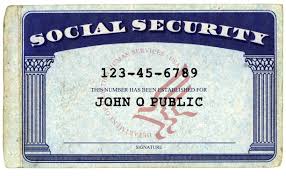
- Social Security Administration — If anyone in your household gets (or soon will receive) disability, retirement or survivor benefits and you live in any of the 50 states, DC, Puerto Rico, the U.S. Virgin Islands, Guam, the Northern Mariana Islands, or American Samoa, log into your account and use Social Security’s online system to change your address; you can also call 800-772-1213, Monday through Friday, 7 a.m. to 7 p.m. EST, but expect to provide information to prove your identity.
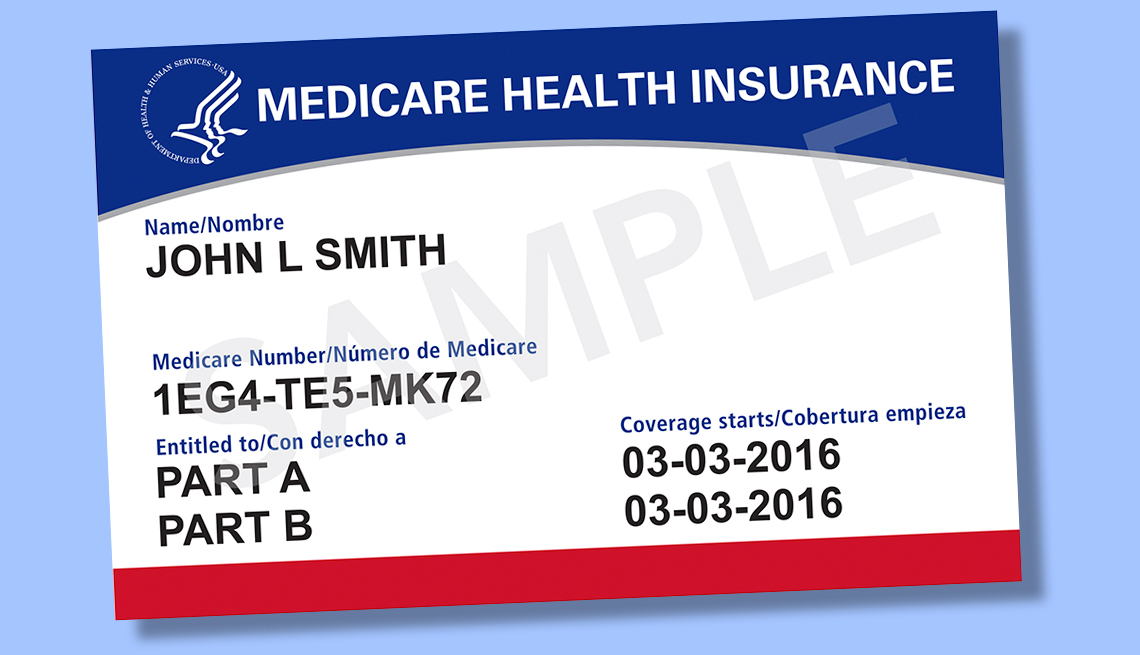
- Medicare — To change your address with Medicare, you must contact the Social Security Administration, as described above.
- Healthcare.gov — If you get your healthcare through the federal exchange rather than a state exchange or private insurance, log into your account and update your current application online. If you are moving within the same state, you can update your application online, by phone, or in person — but not by mail. However, if you move to a different state, changing your address is not enough; you will need to submit a new application and select new health insurance.
- Department of Veterans Affairs — If you or a member of your household has been in the military and receives military benefits (or will in the future), be sure to keep the address updated, either online in your VA.gov profile or use the Department of Veterans Affairs’ change of address printable form. Note that changing it in your online profile will speed the information across all divisions.
This is also important if you are the executor of a will or responsible for the estate of someone with military experience service. Make sure the VA can find you.
- U.S. Citizenship and Immigration Services — Most resident non-U.S. citizens need to report their changes of address within ten days of moving within the United States or U.S. territories; this should be done through your USCIS online account. If there’s a reason you can’t update your USCIS address online, you can download and fill out Form AR-11 to submit an Alien Change of Address Form.
Note that changing your address with the USPS will not change your address with USCIS and USPS will not forward your mail from USCIS, so you’ll want to jump on this.
- Voter Registration Offices — If you move, whether it’s across the street or to the other side of town, you need to update your address with your local board of elections. A change of address even within the same congressional district may still change your voting options for city or town council, school board, and other local issues.
If you move to a different county, city, or state, you’ll need to register to vote in that locale. As you learned in my post on voting, different states have different rules regarding the methods (in-person, by mail, online) for registering to vote and changing your address. You can also register to vote or change your registration information, including your address, via Vote.org.

- Department of Motor Vehicles — Contact your state’s DMV to find their online change of address page (if you’re moving within the same state) or registration information (if you are changing states).
- Toll Pass Agencies — Don’t forget to update your address with whatever toll pass accounts you use. Look at your transponder if you’re not sure what agency handles your toll pass. EZ-Pass, for example, covers twelve states, and services I-PASS in Illinois, and other regional agencies in North Carolina, Indiana, Kentucky, and Florida.
- Unemployment Offices — Depending on your state, relocating while you receive unemployment benefits can be tricky. (If you move to a different state, your benefits will likely end.) Notify your state’s unemployment agency as soon as you being the moving process. In most states, the easiest way to update your address will be to log in to your state’s unemployment benefits online account. If you aren’t sure where to start, the Department of Labor has contact information for all state unemployment insurance offices.
Finally, if you are certified or licensed by your state to fly a plane or maneuver a boat, to fish or hunt, or to perform your profession, be sure to contact that government agency to update your address.
Contact Financial Institutions
Even if you conduct all of your financial transactions online, your providers need to know where you live because some financial rules and regulations are governed by the state in which in the accountholder resides. So, create a checklist for any and all of the following:
- Banks and credit unions where you hold accounts
- Brokerage houses and investment services, for retirement and non-retirement investments
- Credit reporting agencies — Officially, you only need to notify your creditors. However, it’s worth your effort to check Equifax, Experian, and TransUnion after the move to make sure your address has been properly updated. Log in to all three via AnnualCreditReport.com.

Little House Photo by Kostiantyn Li on Unsplash
- Insurance companies — Whether you have auto, homeowners, renters, health, or dental insurance, long-term care or life insurance, umbrella policies, or coverage for your business — if you’ve got insurance, notify them of your address change. In most cases, changing your address will change some aspect of your coverage, especially the cost.
- Lenders — Got credit cards? Auto or personal loans? (Obviously, if you’ve got a mortgage or a HELOC, those will be going away when you move, but the bank will still need to be able to contact you for a while.)
- Online financial accounts — Whether it’s Paypal, CashApp, Venmo, or Zelle, make sure your address is updated in the accounts. Where you reside impacts legal terms and conditions.
Tell the Boss Man (or Boss Lady)
You may not get a physical paycheck anymore, but your employer needs to know where to send tax forms and other official documents.
If you work remotely and change your state of residence, tell your HR department!
Notify Your Utility Companies
When you move, you (generally) don’t take your services with you, but you may keep the same account number. Notify the following when you change your address:
- Electric company
- Gas company
- Sewer service provider
- Trash/Waste/Recycling service providers
- Water company
- Internet service provider
- Telephone companies — You may not have a landline anymore, but you almost certainly have a phone. Be aware that the taxes you pay on cellular phone service are determined by the county in which your account is registered. If you use online billing, it may be to your advantage to keep your cell service registered to your old zip code, but your provider’s Terms and Conditions may not allow this.
- Television service provider — Sure, if you have cable or satellite service, that will change depending on where you move. However, the tax you’re charged for streaming services will change depending on the state to which you move.
- Other entertainment providers — Whether you subscribe to music or gaming services like Spotify or Twitch, or have tangible subscriptions for magazines and newspapers, update your address.
WHO ELSE NEEDS TO KNOW YOU’VE MOVED?
Notifying the above folks will keep you from getting into trouble or debt, but don’t forget all of the other individuals and companies that need to be able to find you.

Household Services
Depending on where you move, your household service providers, whether a big company like Terminex or the nice lady who dusts your piano, will need to know how to contact you, whether to continue providing services or finalize paperwork. Start with these and brainstorm whom else you might need to contact:
- Alarm company
- Housekeepers
- Lawn and garden care
- Pest control
- Pool maintenance
- Snow plowing/shoveling
Healthcare Providers
- Internists/Family practitioners
- Pediatricians
- Specialists (OB/GYNs, ophthalmologists, endocrinologists, etc.)
- Dentists
- Orthodontists
- Veterinarians — If you have a pet with a microchip, update the chip’s registration to reflect your new address so Fido or Fluffy can be safely returned to you!
- Pharmacies, especially online pharmacies
Other Professionals
- Attorney
- Accountant
- Bookkeeper
- Financial advisor
- Personal coaches
- Professional organizer
Schools/Caregivers
- Daycare providers — for childcare, eldercare, or pet care
- School administrative offices — Every school needs your change of address: preschool, elementary, middle, and high schools as well as college, whether you are a student, parent or alumni.
- Tutors — Don’t be so busy with your move that your forget to tell your son’s algebra tutor or your daughter’s piccolo instructor that you moved. It’s no fun to stand at someone’s front door, ringing the bell and having nobody answer.
- Activity administrators — If your kids are in gymnastics or Tae Kwon Do, or you participate in any community organizations, make sure to update your address with them. Yes, the USPS mail forwarding will prompt you to remember this, but the sooner you update this information directly, the less chance there will be to miss something important.
Online Connections
Do you get meals from companies like Blue Apron or Hello Fresh? Make sure your food follows you to your new home.
Do you use food/shopping delivery services like Door Dash or Uber Eats? I’ve seen more than one tweet or TikTok video with someone ordering delivery for the first time in a long time and only realizing after they ordered that the delivery was going to the city where they used to live. (It’s universally agreed that when that happens, you tell the driver to keep the meal and enjoy it!)
Be sure to update your address at Amazon and other retailers where you shop online. Got an Amazon (or other) wish list? Change that address too, or your friends will be upset when they send you birthday presents that you don’t get!
Do you travel? Update your addresses for your hotel, airline and other frequent-user accounts
Tell Your Peeps
You’re not going to forget to give your mom your new address, but remember to update your friends and members of your personal circle, including:
- Extended family and friends — The upside is that you may get sent a housewarming present!
- Civic organizations and clubs to which you belong
- Houses of worship and religious organizations
Business Contacts
I could write an entire post about whom your business should contact regarding a changed address. But for personal mail regarding your professional life, consider:
- Professional associations
- Licensing and certification boards
- Formal networking groups
- Affiliate programs from which you are expecting commissions
All of the above assumes that you’ve moved house in the United States. If you move to another nation, be sure to register your address with the U.S. embassy or consulate in your new country. This will ensure that you receive essential updates about safety, security, and emergencies in your area.
How to Organize and Track Your Packages and Mail
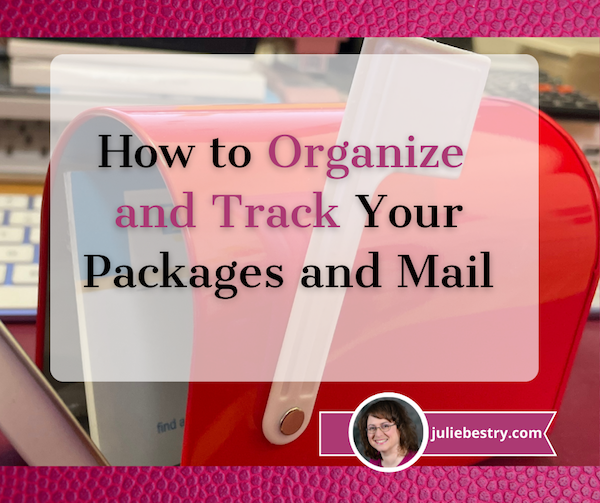
As mentioned before in these pages, Paper Doll loves mail! I love walking to the mailbox to get my mail, opening my mail and culling all the “shiny stuff” (the junk advertising inserted in bills), and picking up packages. I also enjoy sending greeting cards and packages, though I’m as likely as anyone else to let the nice folks at Amazon do most of my shipping for me.
Mail-related disorganization usually starts when people neglect to show up for mail call. Mail piles up, junk mail intermingles with important bills and insurance renewals, and a mess can ensue. We’ve talked before how to make life more efficient by handling mail strategically.
But sometimes, even people who do show up for mail call encounter some frustrations in trying to keep inbound and outbound mail tasks from cluttering their time and space. So, today, I have a roundup of solutions to help you keep tabs on mail and packages.
INFORMED DELIVERY FROM THE UNITED STATES POST OFFICE
Over the past several years, there have been, shall we say, “issues” with postal delivery. Things that used to arrive within a matter of two or three days can now be delayed for a week or more. It’s definitely been a frustration, but we can hope that the $107 billion overhaul of the USPS, via the Senate’s recent passage of the Postal Service Reform Act of 2022, should bring huge improvements. But the USPS has one feature right now that can ease your mail experience.
Informed Delivery is a free service from the USPS. You just sign up for an account using your preferred email address and password. Once you verify your identity, you will get a daily email showing what is due to be delivered to you that day.
The top section of each email shows you a black-and-white photograph of the front of your First Class (letters, cards, bills) and Third Class (advertising and junk mail) mail. For Second Class mail (newspapers and magazines), you generally get a notice that there’s a piece of mail for which there is no photograph. Fourth Class (media mail, like books, CDs, or DVDs) will generally show up under packages.
Below the postal mail section, there are two Informed Delivery sections related to packages: Arriving Today and Arriving Soon. The packages usually have tracking numbers associated with them, so you can see from where an item is traveling with one click.
You can get USPS tracking updates for your incoming packages, add special delivery instructions, manage requested email or text notifications regarding package deliveries, and even schedule redelivery if there’s a potential issue with when a particular package is set to arrive.
Informed Delivery has a secure online dashboard, so you can log in via any browser to see what mail is due, which is convenient if you’re trying to avoid logging into your email (like when you’re on vacation). Once you log in, you’ll have clickable access to any of the past seven days of delivery information, plus a weekly summary count of the number of mail pieces and packages you’ve received.

The dashboard also has a simple checkbox system where you can notify the post office if a package they’ve said would be delivered has not been. I’ve been using Informed Delivery for several years, and can only recall a few occasions where items were not delivered on the expected day, and none where the item did not arrive within one day.
In addition to email and the dashboard, you can also check your Informed Delivery via the USPS Mobile app for iOS or Android.
You may be wondering why you might want to know what’s coming in your mail.
Well, it all depends on your situation. For example, if you’re getting a package with perishable items, you’re going to want to make sure you head to the mailbox soon after the postal carrier arrives to get that package into the house on a sweltering (or frigid) day. Sometimes, you might be getting something in the mail that you want to keep as a surprise from other household members.
For me, it’s helpful to know if I’ve received checks in the mail; the postal carrier arrives after I leave for my client days, so if I know I have a check in the mailbox, I head toward my house, first, after a client session, before heading onward to the bank. (Yes, I can and sometimes do use mobile deposit, but that’s a subject for a different email.)
My mailbox is one of hundreds in two large mailbox banks on either side of my complex’s driveway, about as far as you can get from my front door and still be on the property. I’ll admit, even though I love mail, there are “in-office” days when it’s cold and raining and I really, really don’t want to go out only to find that the only mail I’ve received is a postcard ad. And our mailboxes are tiny (and weird, arrayed like small, vertical shoeboxes), so I don’t want to skip a day only to find, the next day, the box is crammed with two day’s worth of mail. Informed Delivery helps me know what’s what!
THE MAGIC OF GOOGLE
What if you are expecting a package (or have sent a package) and have the tracking number in hand? Sure, you can navigate over to the FedEx, UPS, or USPS websites, but you don’t have to.
Just pop over to Google and type in your tracking number. While you might possibly get other search results as well, you’ll definitely get a prominent box on the screen showing your shipping carrier and tracking number. Click the tracking number and it’ll take you directly to the tracking information for that package and carrier.
Seriously, it’s that easy.
This works great when the sender has given you the tracking number but not told you which shipping company they’ve used. This is common when you make a purchase from a third-party seller through a company like Ebay or Etsy. The sender may even have created the tracking number as a link in a confirmation email — but you know better than to click a link in an email from a stranger, right? Just copy-and-paste the tracking number into Google and you’ll be directed right to the official courier’s tracking page for your package.
HOW LONG IS THIS GOING TO TAKE? CHECK THE SERVICE STANDARDS MAP!
Let’s get back to the post office. Let’s say you want to mail a payment, send a birthday card, or get those save-the-date cards on their way for a big party, an event for work, or a wedding. As long as you’re sending First Class mail, cards, or flats (large envelopes), I’ve got a nifty tool for you.
USPS has a lesser-known service called Service Standards Maps as part of their Postal Pro division:
Select the service type — The USPS refers to this by “originating,” “destinating” (which is not a word in any non-USPS vocabulary, but the meaning is obvious), and “destination entry” (for which I’ve been unable to get a clear explanation).
Select the mail class category — Choose from First Class Letters and Flats, First Class Parcels, Marketing Mail, Package Services, Parcel Select and Parcel Select Lightweight, or Periodicals (magazines/newspapers).
Select the zip code and city name — Note, you can’t type in your 5-digit zip code. Instead, use the drop-down to find the first 3 digits in your zip code, and it’ll show you a corresponding city.
You can also click a box to see the cities in alphabetical order, instead, but be sure to cross-check to make sure the first three digits match your zip code. As we’ve learned from The Simpsons, there are a lot of Springfields out there!
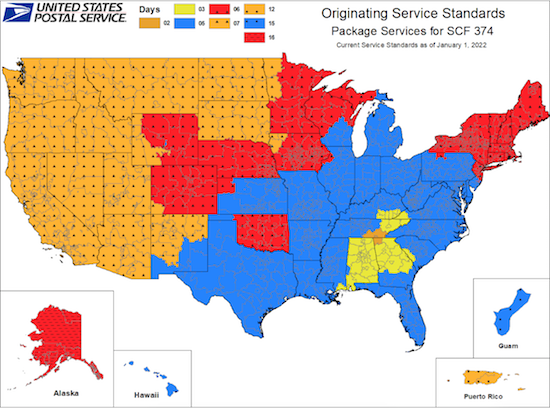
The resulting map will give you a good (and hopefully accurate) idea of how long your mail will take to get where it’s going. It’s not ideal to know that it’ll take three days to get to Atlanta from my house (when I could drive that in 90 minutes) or 16 days to get to Alaska (not that I know anyone there), but forewarned is forearmed!
WHAT IF YOU HAVE A LOT TO SHIP AND TRACK? THERE’S AN APP FOR THAT!
Maybe you’re not worried about mail and shipping for your home and family, but perhaps you sell things and have to ship them hither and yon?
Parcel is a neato-keen shipment tracking tool, but up-front, I’ll warn you that the apps are only for Mac and iOS (including iPhone, iPad, and Apple Watch, in case you need to track your shipments while you’re running a marathon)! You can, however, log in via any browser, if you must.
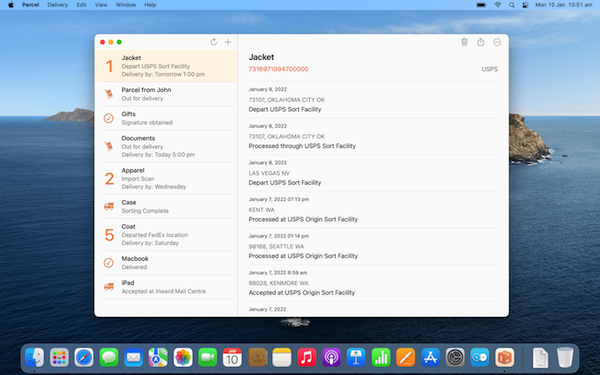
Parcel supports more than 300 different worldwide carriers including FedEx, UPS, USPS, DHL, Royal Mail, and, well, more than 295 more!
Tracking many packages manually is no fun. You’re constantly copying-and-pasting tracking numbers and checking daily to make sure that things are still on their way. Parcel is designed to keep you updated on all aspects of your shipments by notifying you about every “delivery event” with push notifications on any Mac or iOS devices. (However, note that push notifications require a premium subscription for $4.99 per year).
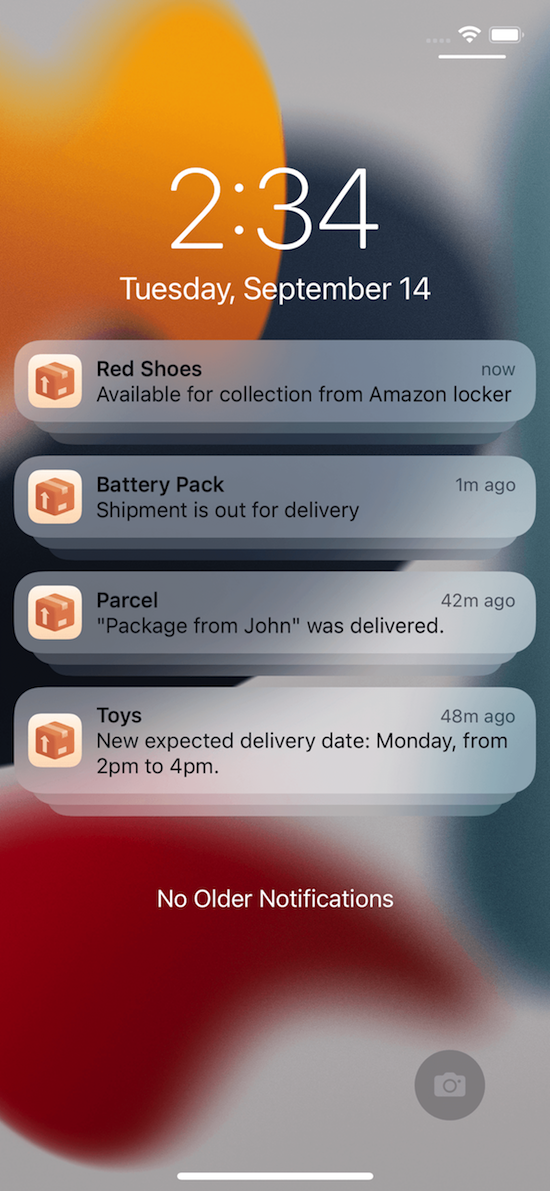
Other Parcel features include finding where your deliveries were and are and seeing that overlaid on a map, a day counter for keeping track of how long your package is in transit, and a barcode scanner. Plus, if you sell items through Amazon, Parcel has a secure Amazon integration.
Of course, Parcel isn’t the only multi-carrier tracker service. There are oodles! Others include:
- PackageMapping — While this site only tracks 17 courier services, if you’re in North America, that should be enough. Not only will you get package status updates by text, but you can see your package’s location overlaid on a map. Animated graphics tell you whether the most recent status for your package was via road, plane, boat, train, and more. (No word on whether there are animations for donkey mail or carrier pigeons.) If you create an account in the app, you can track all of your packages on one dashboard and get tracking notifications.
- Pkge.net tracks 750 delivery services on four continents.
- 17 Track is a free site and iOS and Android app that supports tracking more than 700 international postal services and couriers. Enter up to 40 tracking numbers in a single block on the 17 Track website, and they’ll give you a detailed breakdown of each package’s progress, individually.
WHAT ABOUT GETTING RID OF CARDBOARD BOX CLUTTER?
Do you save every Amazon box you get, because you just know you’ll need a box for shipping something, or for taking donations, or for helping your kid get that working, scale-model volcano to school?
I get it. As a professional organizer, I see lots and lots of cardboard boxes piled up and tipping over, and everyone has a good reason for why. But come on.
How many boxes do you have? Do you even know? Step away from the blog for a minute and go count. Maybe get them all into one room. Scary, I know.
Now, how many boxes have you really (really, really) used for shipping or whatever in the last month? Do you get incoming boxes often enough that you could replenish your stock in the course of a month? If so, it’s time to downsize your box collection.
If you’ve had the box for your microwave or printer (or other similarly BIG cardboard box) for more than a month, it’s time to cut it down, flatten it, and send it to recycling (or offer it up to your neighborhood Freecycle/Buy-Nothing group).
For those small and medium sized boxes, reduce your collection by two-thirds (to start). So, if you have nine boxes from Amazon, Bed, Bath, and Beyond, Kohl’s, or wherever you’ve become addicted to shopping over the past two years, let go of six of them. If you’ve got 24, well, get down to eight but try to let go of more. And then when new boxes come into your home, let go of the older ones. Insects love the adhesive that holds cardboard boxes together, and you don’t want to attract them, right?
For a less unwieldy option for small-to-medium items, consider Scotch Flex & Seal. I wrote extensively about this amazing stuff in This “Magic” Product Makes Shipping Packages as Easy as Wrapping Leftovers back in December 2019. (Ah, we were all so young and innocent then.) The following is an excerpt of what I wrote then.
3M is a marvel of innovation. The same parent company that brought us Post-It® Notes and Command hooks has done it again. They’ve invented a shipping solution that requires keeping less packing material and fewer supplies, takes less time, and creates a smaller dimensional weight for the things you ship.
And, honestly, I’m not persuaded that it isn’t some kind of magic.
Scotch™ Flex & Seal Shipping Roll
First, let’s get an overview of the product, with some fun, bouncy music.
Cool, eh? So, let’s dig deeper. How does this product save space, time, and money?
Eliminate clutter
What do you keep on hand for shipping packages? Boxes, right? Probably lots and lots of Amazon (and other) boxes. Maybe USPS “priority” boxes (which always seem to be way too large or just a little too shallow)? A family member bought a gorgeous Kitchenaid stand mixer and had it shipped. It came in a glossy, specially-carved Kitchenaid box (with a photo of the mixer on the package) inside a matching, plain, cardboard Kitchenaid-branded box (each with specially-placed handles for ergonomic carriage) and the whole thing was inside a box that would have made a nice toddler playhouse.
I bet you don’t just hoard boxes. I bet you have bubble wrap. (And not nice rolls of bubble wrap, but pre-used bubble wrap that someone in your house has popped and flattened along the edges, right?) Or maybe you have styrofoam peanuts. Or those clear, little balloons that look like nothing so much as an inflated zip-lock sandwich bag without the zipper?
And where are you storing these cardboard boxes, bubble mailers, poly bags, bubble wrap, and package stuffing? Probably wherever you can find to put it, and likely not in a very sound system. (No, I’m not peeking in your windows while you’re sleeping. Promise!)
Because the Flex & Seal allows you to customize your package to fit precisely around the edges of your item, there’s no wasted space and no unnecessary padding to keep on-hand. Scotch’s marketing claims to save up to 50% on supplies, time, and space vs. using boxes. I don’t know how they arrived at that statistic, but it does mean that you can take up less space, and the roll can be stored horizontally or vertically, like a rolled-up yoga mat.

Save time
My clients are invariably piling up to-be-shipped items on the dining room table or on kitchen counters because they anticipate (often correctly) that it will be time-consuming to find a suitably-sized box, pad and pack the item(s) safely, and seal everything confidently. Scotch™ Flex & Seal Shipping Roll promises make packing as simple as:
- Cut a piece of the roll long enough to sandwich the item you’re shipping.
- Fold the Flex & Seal over whatever you’re shipping.
- Press to seal it by continuing to press around the three (non-folded) edges. (Imagine you’re wrapping your Thanksgiving leftovers in aluminum foil before putting them in the freezer. Or, as the product’s web site says, “Make sure you’re pressing gray surface to gray surface. A helpful way to remember it: Do not wrap like a present, fold and press like a calzone!”)
That’s it. Print out your label and affix it to the package. Wheeeee!
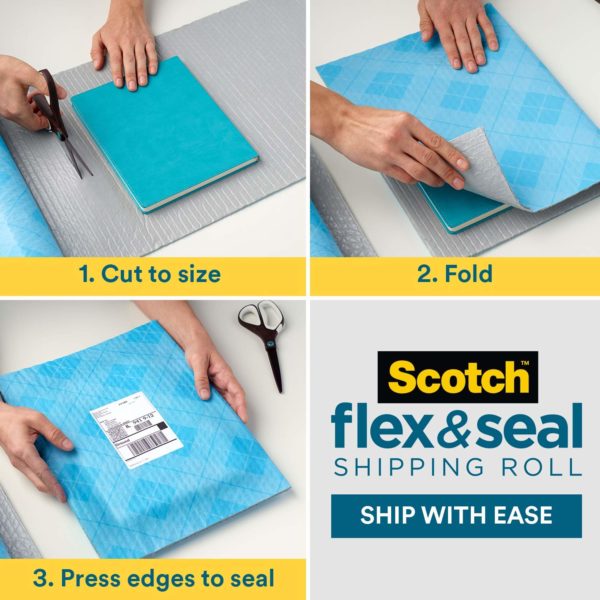
Secure and immobilize your package
Scotch™ Flex & Seal Shipping Roll may look like a prettier version of bubble wrap, but it harbors a secret superpower. Flex & Seal is constructed with three layers.
The blue outer layer is tough and durable, making the package water-resistant and tear-resistant. The clear middle layer is bubble wrap, but seems slightly less inflated (and is difficult to pop), creating firm cushioning for the package.
And the grey inner layer is MAGIC. (OK, I’m sure it’s science, but Paper Doll can’t figure out how it works!) This inner layer’s “adhesive technology” makes it stick securely to itself but not whatever you’re shipping!
Scotch™ Flex & Seal Shipping Roll sticks to itself and not to what you put inside! What kooky shipping witchcraft is this? Share on XOnce you fold the Flex & Seal over your item (sandwiching it), just press firmly for a guaranteed seal. Folded and smushed (for another scientific term), the Flex & Seal conforms to the shape of whatever you’re shipping, immobilizing it to protect against wiggling during shipping.

Save money
The marketing for the Flex & Seal Shipping Roll notes that by eliminating extra packing and shipping supplies, and securely sealing around the shape of whatever you’re shipping, it can reduce the package’s dimensional weight. That should reduce your costs. Yay!
Scotch™ Flex and Seal Shipping Roll comes in four sizes:
- 10′ long x 15″ wide
- 20′ long x 15″ wide
- 50′ long x 15″ wide
- 200′ long x 15″ wide (suitable for small business shippers or people with LOTS of grandchildren)
Scotch™ Flex & Seal Shipping Roll is available online at Amazon and Shoplet, and at Target, Walmart, Office Depot, and Staples. Prices range from about $9 for the 10′ roll to $99 for the 200′ roll.
Wondering about the catalyst for today’s post? I direct you to last Friday’s Twitter thread of frustration, brought on by a two-day shipping problem where FedEx locally couldn’t figure out how to deliver a package, couldn’t communicate with me, couldn’t communicate with their own customer support and vice versa. To solve that, dear readers, it took insisting on being connected with Resolution Support.
So, Tina @FedEx called back today. Left one voicemail on landline w/my correct address but saying they’d been told I have a new one, and another voicemail on my cell, misreading (by one digit) my address & saying they were told I moved. Both messages directed me 1/6 https://t.co/DOsAi0C2yQ
— Julie Bestry, CPO® (@ProfOrganizer) March 18, 2022
Happily, it all turned out fine, in a particularly cheesy way:
To those DMing for details: It was a delayed, Wednesday in Memphis, yesterday & today in Chattanooga, (perishable) birthday present from @CraigJetMetFan via @DakinFarm. The freezy packs were warm but the cheese-y goodness within was still nice and cold. https://t.co/zRn4393ENH
— Julie Bestry, CPO® (@ProfOrganizer) March 18, 2022
A Different Kind of Bankruptcy: Jettison Email Overwhelm

[Editor’s note: This post from the Paper Doll vault was originally published January 13, 2009, back when we were still using two spaces after a period. Sixteen years later, email still plagues people, so this post has been refreshed and updated as of February 2025.]
My parents once told me about a long-lost relative who, when his bank statement got too terribly out of balance, withdrew all but a small amount (estimated to cover all outstanding checks), opened a new checking account at a different bank across town, and abandoned the old one! New bank account, new check register, new sense of freedom.
That long-ago relative declared bankruptcy on his unfathomably unbalanced checking account.
We tend to think of bankruptcy as a bad thing, and certainly by the standard definition, but it’s sometimes the best of a bad set of options. When you lack the funds to pay your bills, bankruptcy is the legal option that allows people (or businesses) to liquidate their assets, create a payment plan going forward, and start fresh without the stress associated with unpayable debts.
But today, let’s look at a different kind of bankruptcy, inspired
EMAIL BANKRUPTCY
In the 21st century, that old story has new wings. For avid web surfers, the idea seemed to have started with a man named Fred Wilson, a venture capitalist. In early 2007, Wilson declared bankruptcy on his blog — email bankruptcy. He wrote, simply:
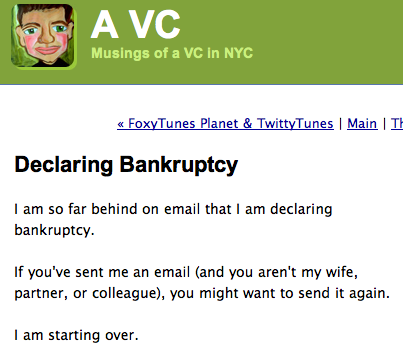
Wow.
While Wilson’s pithy post got linked and tracked and repeated all over the web (and this, in the days before social media), he wasn’t the first.
It turns out the real father of this movement might have been Stanford professor, copyright attorney and Wired columnist Lawrence Lessig, who, in 2004 sent an email to everyone in his address book, apologizing for a “lack of cyber decency” (which, I suppose, we could almost consider 21st century moral bankruptcy), and saying that if anyone was awaiting a response to an as-yet-unanswered email from him, they should reply directly to this particular email, implying all emails that had come before would be ignored.
Lessig apparently saw a declaration of email bankruptcy as the only option to allow him to repay any of his email debts — attacking the most urgent or important would be better than the hopeless and time-consuming attempt to handle them all. With this method, he’d give “creditors” with the most valid claims on his time a chance to recoup their long-awaited loses, and he’d start clean.
Certainly, this method has some appeal. Lessig and Wilson absolutely aren’t the only ones in email bankruptcy court; they’re not even the only high-profile ones. Even musician Moby (known for his high-tech & digitally-designed creations) is reported to have done it.
Although often credited to Lessig, the term email bankruptcy seems to have been coined a full decade ago by MIT Professor Sherry Turkle, and she’s been speaking on the subject for a decade, and as recently as national conferences in 2008. Apparently, the fantasy of freeing oneself from the burden of massive and multiple screens’ worth of email is a common, appealing and compelling one.
The concept for anyone who works at a desk all day is fairly shocking. But isn’t it also intriguing?
As a professional organizer, I’ve seen clients facing this dilemma, with anywhere from hundreds to thousands to tens of thousands of emails in their in-boxes haunting and taunting them. I’m sure you can empathize and see the appeal of this seemingly reckless abandon.
There are great advantages, not the least of which is that unlike financial bankruptcy, you don’t have to wait 7 years to rebuild your online reputation. However, I can’t say I’ve ever encouraged a declaration of email bankruptcy, which seems to involve three steps: alerting everyone to your situation, apologizing, and deleting everything emailed prior to this moment.
I’ve you’re thinking of email bankruptcy, Paper Doll encourages you to consider some compromise measures. Instead of complete bankruptcy, it puts (email) debts in abeyance so that you can focus on what are likely the most pressing obligations.
Peruse the following approach, which can be taken in baby steps. Sit down at your computer, where it’s easier to manage email than on your phone:
- Sort emails by date — Just click the top of the date column, no matter what platform (Gmail, Outlook, etc.) you’re using. It will reorder your emails, just like magic, and is an entirely reversible action.
- Create an email folder called “Archive” so you can move mail (without deleting anything, assuming that’s too scary a step for you).
- Drag old mail (everything from prior to last two weeks) to the Archive folder. It’s staying within your possession, you’re just moving it to a different pile. Of course, if you’ve got 50,000 emails in your inbox, this fear (and anticipating the time it might take) could be paralyzing. If that’s too overwhelming, try carrying over just one smaller chunk at a time, starting with the oldest. If you’re moving 134 emails from July 2008, you’re going to immediately eyeball that “Jeez, I don’t need any of that” and the fear of just moving them out of your inbox will abate.
- Take a deep breath — Remember, you can still do a global search of your email account to find something specific you want. This is just to give you a little elbow (or eyeball) room.
- Now, just handle whatever is current, and you can define that any way you like. — Perhaps that’s the last 10 days or two weeks’ worth of mail in your in box; maybe it’s everything from this calendar year. Only you know what’s going to relieve you from your sense of recent email debt. But be ruthless about processing that email getting it out of your inbox. Use any of the productivity tools Paper Doll has given you. Maybe you’ll want to do a series of Pomodoros to complete the tasks associated with those emails. Maybe you’ll Zoom with an accountability party to body-double one another. And maybe you will recognize that not only can you comfortably delete the email, but you can unsubscribe from the obligation to get more. (It’s like canceling your gym membership when you’re getting billed monthly but realize you’ll never, ever go to the gym!)
- Pat yourself on the back. Having dealt with the most recent email, you should already feel lighter. From here, you have a few options. You can completely stop, or you can organize that whole backlog, knowing you can always use the search function to find any of that older stuff.
- Go to the Archived Folder. Create a sub-folder called “Archive [YEAR] & Prior” or “Before [YEAR]” or something like that.
- Move everything from the Archive folder that’s dated prior to (for example) 01/01/2025 to the sub-folder. In other words, the last year’s worth of stuff is archived, but stuff older than a year is SUPER-ARCHIVED. (If you’ve been using your email inbox as an endless “to do” inbox for years, you may have up to 10 years worth of emails in your box. Chances are good that if you missed anything prior to about 6 months ago, someone has already called to bug you about it.)
At this point, you could just stop and walk away, content that you’ve caught up on what’s truly essential. You could also delete the whole sub-folder, because how likely are you to really need something sent to you between when you got your first AOL account in 1994 and the start of last year?
But just having all your most previous year of email set aside can make it seem more manageable, because if someone does contact you about an email sent a few months back, using your search function to find one email out of a year’s worth will be easier than location one in a decade’s.
Now that things are tidier, you might decide to handle ten ancient emails a day. You could sort that archived folder by sender and look at everything your colleague who retired three years ago sent you to see if anything is vaguely useful, or mass delete everything Kohl’s has sent you since you first got a charge card there. (Seriously, Kohl’s, do you really need to send me three emails every day? I’m not going to forget I have a 40% discount, but more emails aren’t going to trick me into shopping if I don’t already need to buy it at full price. I’m strong that way!
But remember, don’t feel like you have to delete everything from your archive. Inbox:Zero is still only a snapshot in time; people will no more live forever with Inbox:Zero any more than you’ll achieve LaundryHamper:Zero by any method other than becoming a nudist. Email, to our dismay, is here to stay. But getting rid of the ancient and the excess will give you some breathing room to get your work done.
I’m Paper Doll, so why am I talking about email? Because this urge to run away, to abandon your paper debts, is just as strong as that to free yourself of email. Look around — do you have months, even years, of magazines, catalogs, old charitable requests, junk mail, greeting cards, credit card statements, and loose papers surrounding you? Wouldn’t it feel good to be free? (Wouldn’t the foundation of your house be less likely to creak under the weight of it all?) To that end, consider similar bankruptcies.
CATALOG BANKRUPTCY
It’s January. Last year’s (or last decade’s) prices don’t magically stay valid just because you’ve saved the catalogs.
- Get a recycling bin and dump every catalog into it.
- If you REALLY think you’ll order from any of these catalogs, take a minute to bookmark the URL so you can surf anytime you like.
- If you’ve spotted a turned-down page bearing a product you simply must have, tear out just that page–catalogs print their names/URLS/phone numbers on at least one side of every page. Surf the site, bookmark the product page in a bookmark folder called “pending purchases” and recycle the paper.
- Call the 800 numbers and take your name off their mailing lists.
MAGAZINE OR NEWSPAPER BANKRUPTCY
Do you hand-write a transcript of every episode of Oprah? (No!!!) Then you don’t need to save every issue of O Magazine! If nobody is paying you to be an archivist, stop taking that on as a responsibility. [Editor’s Note: Oprah’s magazine may be gone, but the concept still stands.]
- Read what I had to say about magazine clutter last year, here and here.
- Go back and read it again. This time, take it to heart. Owning a magazine does mean you have a slightly greater potential to gain the knowledge within, but it’s only potential unless you actual read the articles, retain the information and release the magazine back into the wild. Set them free!
- Start by making some rules to make the pain of letting go a little easier. Perhaps you can save just the fancy-pants Holiday Issue of each magazine and let go of other months?
- Recognize that old news is history; if you haven’t read Time or your local paper from last April or even last week, trust me, your life will be none the poorer.
- Affirm that there’s not that much new under the sun; if you throw out an issue emblazoned “A Flatter Belly in 30 Days,” be assured “A Tighter Tummy in 4 Weeks” will probably appear in your mailbox next week, anyway.
- Trust Paper Doll (and failing that, Antiques Roadshow) that your 6-year-old National Geographic issues and daily papers will not become collectors’ items.
- Stop renewing subscriptions to magazines you don’t read in full by the time the next issue arrives. Really. (If you miss them that much, go read them at the library where the magazine clutter gets managed by the staff.)
- Donate the magazines to doctor’s office waiting rooms (where they’ll still be decades fresher than whatever is there) and enjoy your free space.
JUNK MAIL BANKRUPTCY
- Do a reality check. Last week, there was a vigorous discussion on social media regarding how so very many of us spent our childhoods coveting Samantha’s or Tabitha’s magical twitches (from Bewitched). But we accept it’s not going to happen. Now it’s time to face another truth. You are very unlikely to win a magazine clearinghouse’s million dollar sweepstakes. Your time is too valuable to play affix-the-sticker-on-the-contest-form, and we’ve already determined you don’t need new magazine subscriptions.
- Donate or don’t, but make a decision. Too many people hold onto charitable donation requests for week, months or even years. There’s no more or less inherent value in replying to any given request from the same non-profit (except, quite possibly, letting their marketing firm make suppositions regarding which design was more popular).
- Shred convenience checks and any other “junk” mail that bears any personal information. It’s junk if you don’t want it, but that doesn’t mean it’s not appealing to dumpster-diving identity thieves.
There are dozens of ways you can free yourself by declaring a positive kind of bankruptcy. Starting today, think about what else you can jettison: tasks and obligations that don’t fit your goals so you can spend more time with your loved ones? Email newsletters you only subscribed to so you could read the bonus ebook? Delete those apps you never, ever use!
Set yourself free! Declare bankruptcy.




Follow Me